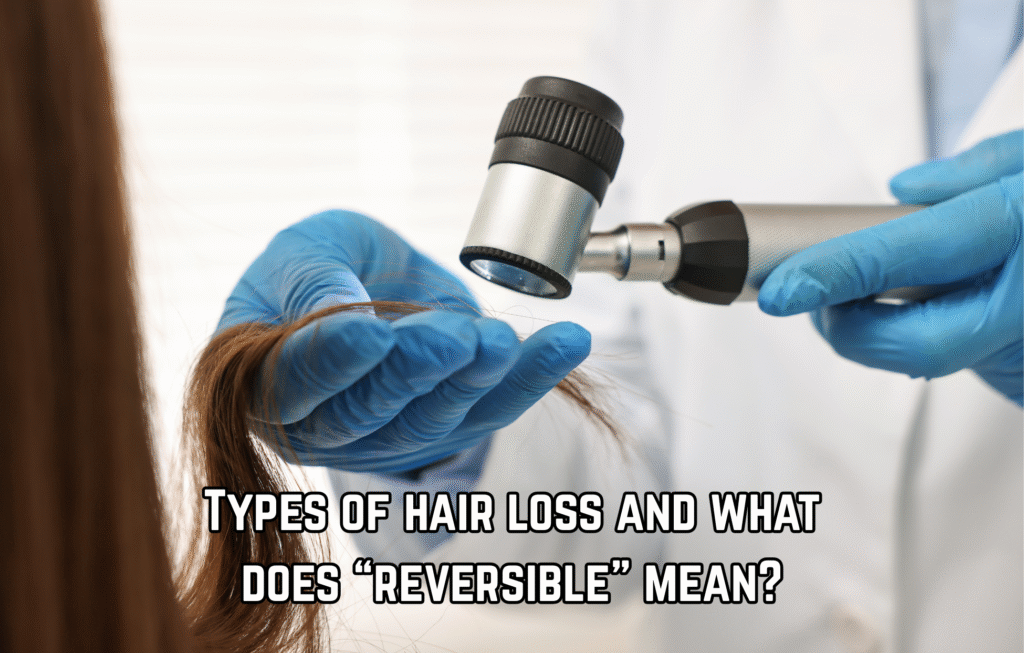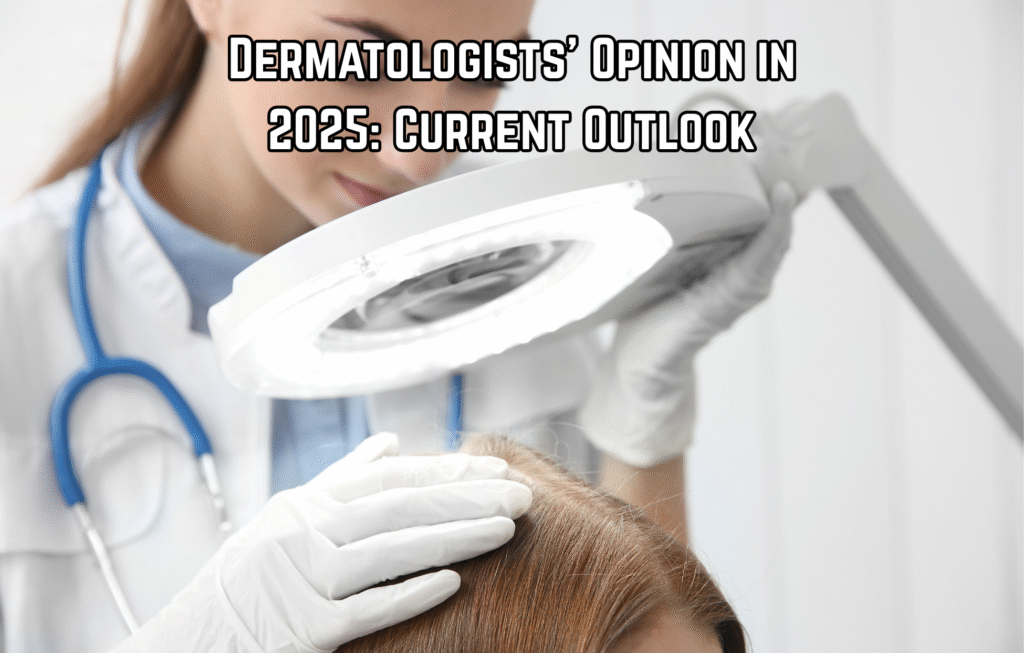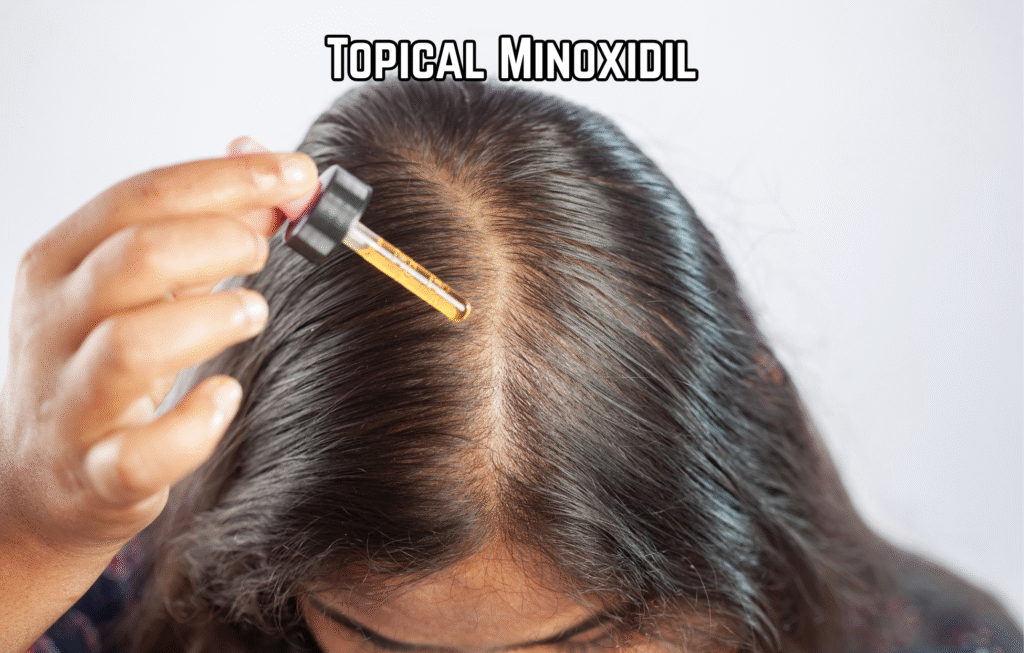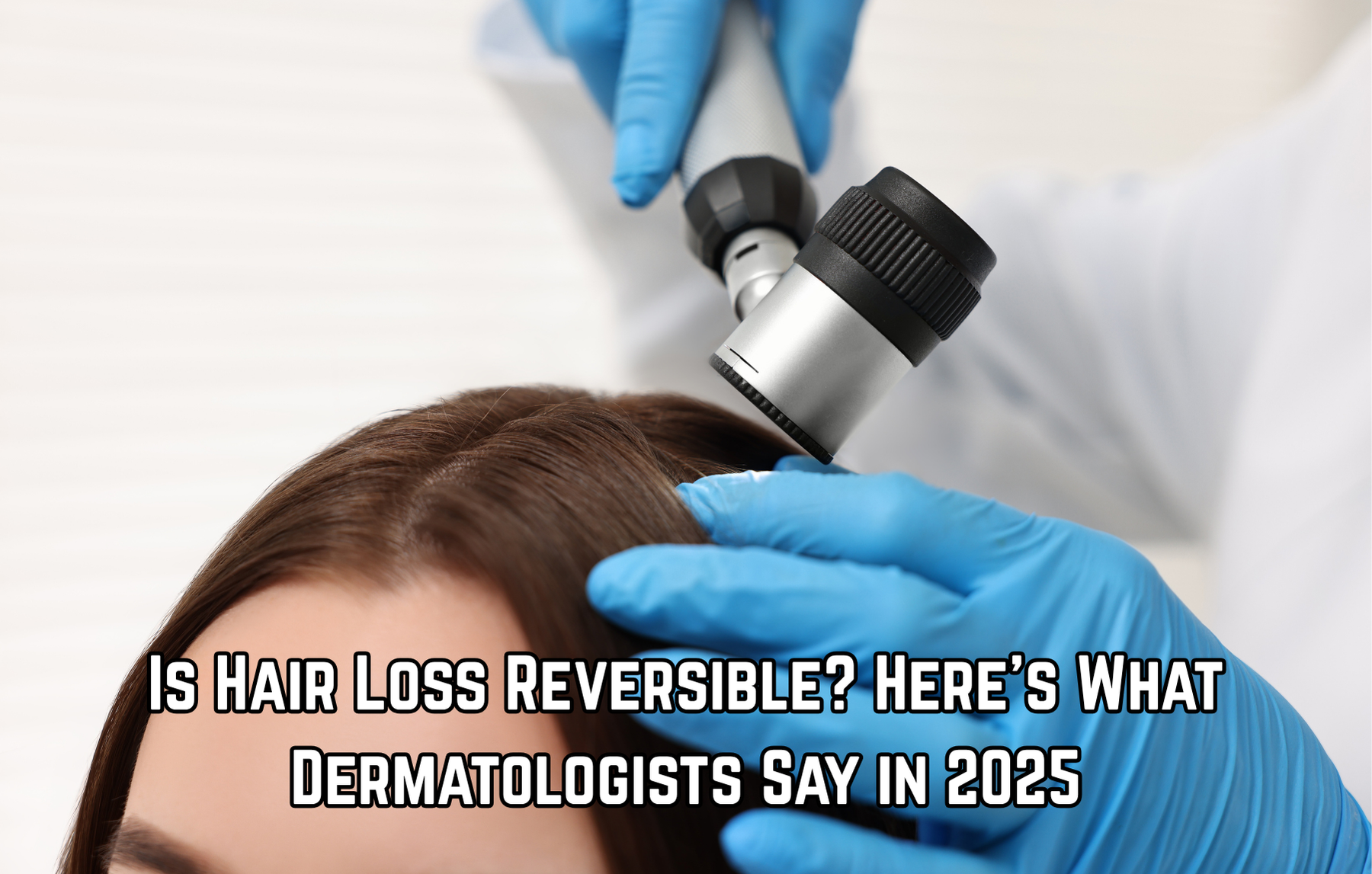Introduction: Can hair loss actually be reversed?
Hair loss always affects individuals psychologically. We hear all the time, “Yes, hair loss can be reversed.” But it is much more somber reality than that. In 2025, dermatologists estimate that certain forms of hair loss—if caught early enough and treated properly—can be reversed to some degree or entirely, but in other instances, it’s better to stabilize or restrict the changes.
Our understanding has improved over the past few years—we now know more clearly which hair follicles are truly dead and which are “dormant”—meaning they are dormant and can become active again when given the right cue. Now, it’s being discovered that some new treatments can actually “awaken” a follicle, not just slow further loss.
Let’s take a closer look.
Types of hair loss and what does “reversible” mean?

When treating hair loss, dermatologists tend to classify two general categories—non-scarring and cicatricial. The condition involved and when treatment is initiated dictate how much regrowth can occur.
The non-scarring category
Under this category, there are still follicles, but they either remain dormant, miniaturized, or their growth is inhibited. Representative examples include pattern hair loss (male/female), telogen effluvium (acute hair shedding secondary to some causes), and autoimmune in nature like alopecia areata. Regrowth is achievable if the causative factor is eliminated or managed.
- Scarring Category
These are the conditions when inflammation or some other factor kills the follicle structure itself, leaving behind scar tissue. Once destroyed, it is unlikely that complete recovery takes place. A few methods can slow it down, but restoring all the lost follicles is extremely challenging.
By “reversible,” physicians typically refer to the following conditions:
- Halting additional loss
- Regrowth of vellus or intermediate type hair
- Greater thickness and healthy growth of hair
- Best-case scenario: restoration of thick, dense hair in the affected area
But if hair loss has been chronic or there is extensive follicle damage, it may not be possible to go back “the way it was.”
Why is some hair loss permanent?
It’s helpful to understand that not all forms of hair loss can be reversed. There are a few reasons for this:
- Miniaturization of follicles over time
Follicles in pattern hair loss slowly get smaller and yield progressively shorter and thinner hairs. With time, they become so fragile that regrowth is impossible. - Depletion or exhaustion of stem cells
Stem cells are very important for hair follicles. If the stem cells become depleted or their signaling environment altered, follicles will not be able to regrow. - Fibrosis/Scarring
Inflammation which occurs in scar-forming alopecia kills follicles and fills them with distorted scar tissue. Regrowth in such regions is very challenging. - Ongoing suppressive signals
With time, molecular mechanisms within the body get modified, inhibiting growth signals—leading to follicles being “dormant.” - Increased Periods
If a follicle is dormant for an extended period, its structure, blood vessel supply, and the tissue around it can slowly reduce, thus making it harder for it to regrow.
Thus, the earlier it is detected and treated, the higher the chances.
Dermatologists’ Opinion in 2025: Current Outlook

Doctors in 2025 are starting to realize that “reversal” is really a ongoing possibility—not a yes or no—and the result relies on the person, type, length, and treatment. Some of the new trends are:
Not Dead, Quiet: The Dimension of Dormant Follicles
The most thrilling development is that it is now thought that most “bald spots” are not so much dead as dormant—they have ceased growing unless signaled to do so. A study by Indian-Americans published in Stem Cell Research & Therapy demonstrated that pattern hair loss entails a derangement of the inner signaling network—i.e., follicles enter “sleep” instead of dying off altogether.
If this is verified (and human trials are initiated), we’ll have the ability to stimulate these follicles—ie, a change from “preventing hair loss” to “encourage new hair growth.”
UVA University research has made another fascinating find: the top and middle layers have some stem cells which nourish or signal the bottom layers. In the balding region, there is still hope that these cells may become active if they receive the proper signals.
Advances in Autoimmune Hair Loss (Alopecia Areata)
Alopecia Areata is an autoimmune disorder where the structure of the follicles is intact, but an immune assault closes them down. In 2024, a new approach was presented—the microneedle patch—which releases molecules such as IL-2 and CCL22 slowly over time into the scalp.To increase immune regulation. This approach was shown to stimulate hair regrowth in mice.
This strategy can safely yield localized immune regulation, which has fewer side effects than broad immunosuppression.
Animal and Preclinical Revolutions
In 2025, in a mouse study, fat-derived stem cells were combined with ATP (a molecule of energy) to achieve hair regrowth in a model of pattern hair loss. Full hair regrowth was noted in male mice, and 90% of females had notable hair growth. This indicates that regenerative therapies are no longer a dream.
These success stories indicate that future treatments will not only stop further hair loss but also try to awaken damaged or dormant follicles.
Practical Thinking for Dermatologists
Despite these scientific breakthroughs being made, dermatologists remain grounded. They stress the following:
- Early onset is essential — The earlier treatment is initiated, the better the outcome.
- Not everyone will have full regrowth — Outcomes depend on age, duration of hair loss, genetics, conditions of the scalp, and treatment compliance.
- Continuity is the key — Treatment is often continued for longer, the more benefit is gained.
- Combined treatment is the norm — Topicals, drugs, devices, and lifestyle are combined, not offered singularly.
- Evidence and safety are paramount — Prudence is recommended against methods lacking evidence or with “miracle” advertising.
- Personalization is on the rise — Treatments today are personalized to a person’s genes, hormone levels, scalp status, and follicle biology.
Current and accepted treatments (widespread use in 2025)
While regrowth methods are not yet widespread, physicians currently use treatments that have decades of experience and acceptance:
Topical Minoxidil

Minoxidil is a liquid or foam solvent applied to the scalp that increases blood flow and can even stimulate follicles. It is particularly valuable in thickening miniaturized hair or arresting further loss, but regrowth of follicles is less successful in totally bald areas.
Oral medications (finasteride, dutasteride, spironolactone)
- Finasteride (1 mg daily) is approved in men — it blocks an enzyme known as 5-alpha-reductase, lowering DHT (dihydrotestosterone), which enhances follicle reduction.
- Dutasteride is a more active drug, inhibiting several 5-AR isoforms, and is occasionally prescribed off-label.
Spironolactone is applied in women, particularly where there is a hormonal imbalance, as it has the ability to act by decreasing androgens (male hormones).
These drugs take some months (3–6 months or longer) to be effective, and if stopped, the effects can be lost.
Low-Level Laser Therapy (LLLT) / Light Devices
Low-level laser or LED equipment (caps, helmet style) will stimulate follicles and provide density with ongoing use. It is frequently combined with other treatments.
Microneedling and Stimulation of the Scalp
Microneedling is one technique for activating growth factors in a region through producing tiny, controlled traumas. This enables topical medications to be absorbed more effectively and “wake up” sleeping follicles. It’s usually paired with minoxidil or PRP.
Platelet-Rich Plasma (PRP)
In this procedure, an individual’s own platelets (drained from the blood) are injected or sprayed into the scalp since they have higher concentrations of growth factors. Some physicians see this as a beneficial technique—proof is inconclusive, but numerous patients have had improvement.
Lifestyle and Nutrition Support
Physicians frequently suggest: correct iron, vitamin D, vitamin B12, or zinc deficiencies; reduce stress; sleep adequately; control thyroid or other hormonal conditions; and keep the scalp from being ruined by chemical application or hair styling.
Future Technologies and Research Directions
Throughout 2025, a number of technologies are under development and moving toward clinical trials:
Signal Modulation and Small Molecule Activators
As many cases of hair loss are caused by “lost signals,” researchers are working on small molecule drugs that can reverse such signals. Some test drugs are valproic acid or CHIR99021.
Other technologies, like CRISPR-gene editing (CRISPR)—where genetic flaws in the follicle are corrected directly—are being considered, but human applications are still not in the near horizon, and there are issues with safety, ethics, and approach.
Stem Cells and Regenerative Medicine
Stimulation or transplanting of follicular stem cells is an extremely hopeful approach. Activities such as the UVA study have already shown that dormant stem cells can still be present.
Researchers are also attempting to develop scaffolded biomaterials or artificial (engineered) follicles in order to trigger regeneration where follicles are fully dormant or partially missing.
Localized immune modulation
In autoimmune alopecia, immune modulation on the scalpTreatment like microneedle-delivered micromolecules could be safer methods, permitting localized alteration without a suppressive effect on the whole body’s immune system.
“Smart” Topical Formulas and New Compounds
Certain new compounds, like “PP405” and topical “Botox-like agents,” are under testing in the lab or specialized clinics, which might revitalize latent follicles or modulate local manifestations.
AI and Advanced Diagnostic Tools
Imaging, artificial intelligence (AI) technology, and scalp diagnostic advancements are allowing hair loss to be detected earlier and treatment response to be monitored more effectively. For instance, an AI platform named “ScalpVision” is a computer model that can automatically quantify the number of hairs and their condition.
When is it easier or more difficult to reverse baldness—what are your prospects?
Some of the reasons why your baldness is more or less reversible are given below:
- Type of hair loss — Non-scarring hair loss is more likely to return.
- Duration of hair loss — If hair loss has begun recently, the likelihood of reversal is higher.
- Age and genetics — The body’s reproductive capacity is better at a younger age; however, if your genetics are strong, the challenge may be greater.
- Follicle condition — If the follicles are just dormant and not totally harmed, recovery will be better.
- Early treatment initiation — The sooner the treatment is initiated, the more favorable the results.
- Regularity of treatment — Those who attend treatment regularly experience better results.
- Associated health conditions — If your hormones, thyroid, vitamin levels, stress, etc. are fine, growth is better.
- Scalp condition — If there’s good circulation, no scarring, and a healthy cellular structure, this is a more favorable environment.
If your hair is thinning, has fallen out temporarily, your scalp is healthy, and you do what your doctor tells you — you’re most likely going to experience a good deal of improvement.
Realistic Expectations & Things to Ask Your Doctor
When you visit a dermatologist, remember the following:
- What is the type of hair loss — non-scarring or scarring?
- How long has it been occurring?
- What procedures will be performed — blood work, scalp biopsy, imaging?
- How long may noticeable changes take to occur after initiating treatment? (Typically 3–6 months)
- What integrated treatments (topical + oral + devices) will be used?
- What are the side effects or dangers of these treatments?
- How long do I have to follow this treatment in order to preserve the obtained effect?
- Can I take part in innovative treatments or clinical trials?
- How can I enhance my lifestyle or scalp (nutrition, stress, haircare, sun protection, etc.)?
Remember that each individual will experience different results—some experience a lot of hair regrowth, some experience only thinning improvement or cessation of hair loss.
Conclusion: Hair loss reversal by 2025—not out of the question, but challenges exist
- Partial or full reversal can happen in most cases—particularly non-scarring types, if diagnosed and treated early.
- But, 100% recovery isn’t always possible—if shedding has been ongoing for a long time or the follicles have been severely damaged.
- The biggest change in 2025 is that many follicles previously considered “dead” may actually be in a quiescent state, and new technologies can reactivate them.
- The current approved therapies (minoxidil, finasteride, microneedling, PRP, etc.) are still in the limelight, but technologies such as regenerative medicine, signal control, and AI diagnostics are progressing very quickly.
- Your best course of action is to go see a physician as early as possible, follow evidence-based therapies regularly, and adhere to a safe and proper plan specific to your case.
FAQs
Can hair loss actually be reversed?
Yes, a few kinds—particularly non-scarring hair loss—can actually be reversed in part or entirely if it is treated early. Scarring hair loss, however, is usually permanent and more difficult to reverse entirely.
What are the reversible forms of hair loss?
Non-scarring conditions such as pattern baldness, telogen effluvium, and alopecia areata are usually reversible. Scarring conditions involve destruction of the follicles, and therefore regrowth is unlikely but stabilization can occur.
What does “dormant” hair follicle mean?
Dormant follicles are dormant, not dead. They can re-grow hair with proper treatment or stimulation—unlike destroyed follicles in scarring alopecia, which cannot be restored.
Hi, I’m veda, a professional health content writer and passionate wellness advocate at HealthTipsIndia.com
. With years of experience in writing evidence-based, reader-friendly articles, I specialize in creating content that empowers people to live healthier, more balanced lives. Whether it’s nutrition, fitness, natural remedies, or preventive healthcare, I translate complex medical concepts into actionable tips tailored for the Indian lifestyle. My goal? To make trustworthy health information accessible to everyone—one article at a time.

